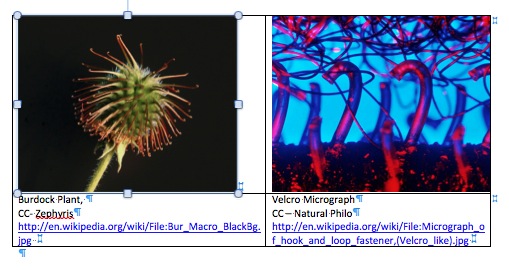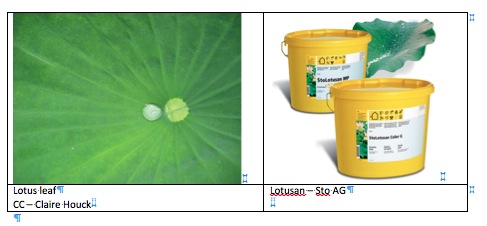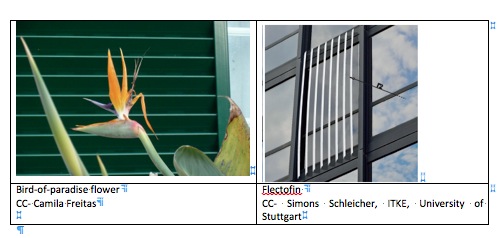Biomimicry, Biomimetics, Biologically Inspired Design : much more than inspiration
By Camila Freitas
There are many human inventions which were inspired by observations of the living (and non-living) systems that surround us. The systematic study of the systems of nature with the aim of helping engineers has started to receive greater interest since the 60s: terms such as bionics and biomimetics were created to refer to these approaches aiming specifically at using the knowledge gathered from living systems to improve human-created technology. The idea behind these two terms was that copying or mimicking some function, some characteristic of the natural systems would be useful for improving technical systems. The publication of the book “Biomimicry, Innovation inspired by Nature” in 1997 by the American science writer and lecturer Janine Benyus gave a new impulsion for the so-called biologically inspired approach or biomimicry which is defined as “a new science that studies nature’s models and then imitates or takes inspiration from these designs and processes to solve human problems” [1].
Numerous associations of biomimicry practitioners and people interested in the approach were created: BIOKON (Germany), the Biomimicry Institute (co-founded in the US by Benyus), Biomimicry Europa (Belgium and France), Biomimicry NL (Netherlands), Biomimicry IL (Israel), Biomimicry UK. In France, a dedicated research center is being built in the town of Senlis (CEEBIOS). And the number of publications on the biomimicry / biomimetic field keeps growing [2].
This article presents some examples of biologically inspired products and recent developments and also some perspectives about the use of biological inspiration in innovative design.
Some “successful” examples
There are numerous publications related to biologically inspired developments. The two books of Y. Bar-Cohen [3,4] for example, give a wide set of examples spanning different technological fields in which biological inspiration has been applied to. The most emblematic examples, gathered from literature on biological inspiration are:
1) George de Mestral’s Velcro®
George de Mestral, a swiss engineer, observed that the seeds of burdock plant got caught in his dog’s fur [5], being easily removed with a light force. He analyzed these seeds and attributed the gripping to the tiny hooks that cover the seeds surface. Velcro was then created as a two sided zip, which contains in one side stiff hooks (as in the burdock seeds) and on the other loops to which the hooks get attached. The name Velcro came from the contraction of the words velour (velvet) and crochet (hook) [6].
2) Self-cleaning surfaces
Lotus-leaves have long been recognized as a symbol of purity, as it grows in muddy environments and always stay clean. Two German researchers, Barthlott & Neinhuis, while doing some studies on plants surfaces, unveiled the mechanism that allowed these plants to stay clean. They discovered that leaves such as the lotus, had a rough surface covered with a hydrophobic coating [7]. This allowed the development of microstructured hydrophobic coatings being employed as paints for rendering surfaces self-cleaning (ex. Lotusan, developed by Sto AG)[8].
3) Eastgate Center
The Eastgate Center, in Zimbabwe, was projected by the Zimbabwean architect Mick Pearce. He drew its inspiration from the termite mounds of southern Africa termite mounds, which were believed to provide ventilation and temperature control for the colony. The ventilation system of the building was built using two models of termite mound ventilation: the thermosiphon and the induced flow, and steady temperatures are achieved without massive energy consumption for air conditioning. However, Turner and Soar [9] pointed out that “there is no evidence that termites regulate nest temperature” and the ventilation has no or little to do with the temperature regulation. This shows that even not fully understood biological phenomena can lead to interesting biologically inspired developments.
4) Flectofin®
Flectofin® is the result of collaboration between German engineers, architects and botanists. Reducing complexity of deployable systems in architecture is a challenge for architects, as in general deployability is achieved using “rigid elements connected with technical hinges” [10]. In Nature, this property is achieved using different mechanisms, such as the elastic deformations in plants. This was the starting point of a screening process for finding plants movements that would be useful for technical applications. The bird of paradise flower petals movements were identified as a torsional buckling mechanism, known to engineers, but usually considered as a failure mode, to be prevented. The plants movements showed how to use this mechanism, which was abstracted in a “thin shell element attached to a beam” [11]. Further studies on the materials properties and simulations allowed the development of Flectofin, described as a façade shading system formed by bending lamellas that is also adaptable to curved geometries.
5) Nature-inspired algorithms for optimization
Steer, Wirth and Halgamuge, in a review about these algorithms [12] propose that natural systems may exhibit behavior that is optimum-seeking, which could be used in artificial applications, while others act like “methaphor” inspiring, providing a framework for problem understanding and for the production of solutions. Their review included the following examples of nature-inspired algorithms :
- Evolutionary algorithms, inspired by the Darwin’s theory of Evolution by Natural Selection (“evolutionary operation”, “genetic algorithms”, “evolution strategies” and “evolutionary programming”).
- Particle Swarm Optimization, inspired by social behavior in nature.
- Ant Colony Optimization, inspired by the “recruitment strategy of ants which use chemical markers to mark the source of a rich food source”.
- Artificial Neural Networks, inspired by the central nervous system of many organisms.
These examples show that the biologically inspired designs are rarely a copy of the inspiring achat de viagra en belgique natural system, they in fact involve an interaction between the knowledge from biology and the technical knowledge: normally observing the biological systems allow an activation of knowledge that would not otherwise be activated: for example, who would think that roughness could produce self-cleaning surfaces? Or that a materials failure mode could be the key for improving deployability?
Including biological inspiration in R&D
The growing number of publications involving biomimetics in different scientific fields and the innovations some of them brought, attracted the interest of many companies, seeking to be more innovative.
The first and more classic use of the biological knowledge in companies can be as a means of stimulating idea generation. Asking engineers: “how our problem is solved in nature?”, can stimulate them to analogically generate new ideas for their problems. Nevertheless, the examples mentioned above highlight that only the analogy may not be sufficient for finding the disruptive path: some further research in the biological knowledge may be necessary. For example, in the flectofin case, a screening process of different plants mechanisms was necessary, in the Eastgate centre, the two ventilation mechanisms needed to be uncovered.
As a consequence, engineers may require an easy access to the biological knowledge, which will allow them to lately contact specialists. This access can be achieved by using databases containing biological phenomena, such as Asknature.org [13] or by searching in biological literature, as proposed in the Natural Language Approach [14]. There are also computational tools being developed for facilitating the transfer between the biological knowledge and the technical knowledge [15]. Therefore, the encounters between engineers and specialists may produce some interesting mutual inspirational interactions: engineers will propose biologists new questions about their work and biologists may propose new interpretations or regards about engineers’ problems. These questions are currently being studied at the chair “Design Theory and Methods for Innovation”, with the C-K theory as a framework for understanding the different roles of biological knowledge in the biologically inspired design process and for demonstrating that biomimetics indeed allows designers to go beyond mimicking or inspiration.
References
[1] Benyus, J.M., 1997. Biomimicry : innovation inspired by nature. William Morrow and Co.
[2] Lepora, N.F., Verschure, P., Prescott, T.J., 2013. The state of the art in biomimetics. Bioinspiration &
Biomimetics 8, 013001.
[3]Bar-Cohen, Y., 2005, Biomimetics: Biologically Inspired Technologies, CRC Press, 552p.
[4] Bar-Cohen, Y., 2011, Biomimetics: Nature-Based Innovation, CRC Press, 788p.
[5] Velcro Industries, History, available at: http://www.velcro.co.uk/About-Us/History.aspx
[6] Bhushan, B., 2009. Biomimetics : lessons from nature – an overview. Philosophical Transactions of the Royal Society A : Mathematical,Physical and Engineering Sciences 367, 1445-1486.
[7] Barthlott, W., Neinhuis, C., 1997. Purity of the sacred lotus, or escape from contamination in biological
surfaces. Planta 202, 1-8.
[8] Sto Lotusan Coating for exterior EIFS Stucco & Concrete, available at: http://www.stocorp.com/index.php/component/option,com_catalog2/Itemid,196/catID,43/catLevel,5/lang,en/productID,34/subCatID,44/subCatIDBP,44/subCatIDnext,0/
[9] Turner, J. and Soar, R.J., 2008, Beyond biomimicry : What termites can tell us about realizing the living building. In proceedings of the First International Conference on Industrialized Intelligent Construction (I3CON), Loughborough University.
[10] Flectofin®: a hingeless flapping mechanism inspired by nature, 2012 – Available at: http://www.itke.uni-stuttgart.de/flectofin/flectofin_brochure.pdf
[11] Knippers, J., Speck, T., 2012. Design and construction principles in nature and architecture. Bioinspiration & Biomimetics 7, 015002.
[12] Steer, K.C.B, Wirth, A. and Halgamuge, S.K., The rationale behind seeking inspiration from nature. In: Nature-Inspired Algorithms for Optimisation, Studies in Computational Intelligence, 193, pp. 51-76.
[13] AskNature – available at : http://www.asknature.org/
[14] Shu, L., 2010. A natural-language approach to biomimetic design. AI EDAM 24, 507-519.
[15] DANE : Design by Analogy to Nature Engine – GeorgiaTech – available at: http://dilab.cc.gatech.edu/dane/
Résumé:
There are many human inventions which were inspired by observations of the living (and non-living) systems that surround us. The systematic study of the systems of nature with the aim of helping engineers has started to receive greater interest since the 60s: terms such as bionics and biomimetics were created to refer to these approaches aiming specifically at using the knowledge gathered from living systems to improve human-created technology. The publication of the Janine Benyus book: “Biomimicry, innovation inspired by Nature” has also contributed for the renewed interest on this approach and on the sustainability improvements that could be achieved by getting inspired by Nature’s systems. Many scientific and non-scientific associations and networks of biomimetics practitioners were formed, such as the BioKon (2001, Germany), the Biomimicry 3.8 Institute (2006, USA), Biomimicry Europa (2006, Belgium), Biomimcry IL (Israel, 2009) and other associations around the world.
Some examples of applying biological inspiration during the design process include the Velcro®, inspired by the seeds of burdock plant, the Self-cleaning surfaces, inspired by the water repellent and structure properties of the surface of the lotus leaves, the Eastagate Center, inspired by termite mounds, or the optimization algorithms inspired by behaviors and characteristics of naturals systems, as in ant-colony or particle swarm optimization. These successful examples are stimulating the research and development in industry to apply biological inspiration as another creativity and stimulation approach. Besides stimulating the idea generation using analogies to natural systems, i.e. by answering the question: How would nature solve my problem?, the examples of bioinspiration show that an expansion in the biological base is necessary for finding and developing the disruptive path indicated with the biological inspiration. These new interactions between knowledge bases and professionals (biologists, engineers) are the main difference between bio-inspired design and other forms of design and show the potential for rupture that this approach can bring to design.




